I often receive thoughtful emails from you about these blogs. I consider your questions carefully. The first time you asked, “Why do you use dashes when you write?” it aroused my curiosity. A more recent email asked the question this way and it stopped me in my tracks: “Do you use dashes the way Emily Dickinson uses them in her poems?” I apologize for the silly grin on my face, but considering my use of dashes in the same sentence with Dickinson’s use makes me giggle.
To be serious, you did make me wonder about the correct grammatical use of dashes, so I did some research. They're formally called em dashes, and the punctuation guide I found says: “The em dash is perhaps the most versatile punctuation mark. Depending on the context, it can take the place of commas, parentheses, or colons — in each case to slightly different effect.”
To be honest, I had not taken note of the use of dashes by Emily Dickenson. When I investigated, I learned this from the critic, John Giglielmellon:
“Emily’s dashes give you pause to receive the enormity of what she is attempting to convey. They link separate realms in her mysterious landscape — a curtsy or quick intake of breath as she unveils her gem.”
I needed to judge for myself and I urge you to do the same. Here’s one of her poems followed by scholarly opinions about her use of dashes.
POEM
I’ll tell you how the Sun rose –
A Ribbon at a time –
The steeples swam in Amethyst
The news, like Squirrels, ran –
The Hills untied their Bonnets –
The Bobolinks – begun –
Then I said softly to myself –
“That must have been the Sun”!
But how he set – I know not –
There seemed a purple stile
That little Yellow boys and girls
Were climbing all the while –
Till when they reached the other side –
A Dominie in Gray –
Put gently up the evening Bars –
And led the flock away.
– EMILY DICKINSON
OPINIONS
The Emily Dickinson Museum says William Harvey Wells' Grammar of the English Language condoned Dickinson’s unorthodox use of dashes, and Lee Ballantine, a critic, opined that:
“Emily Dickinson was a monumentally original artist and innovator. Conventional punctuation and for that matter prosody (I had to look up prosody. It means “the patterns of stress and intonation in a language.”) did not serve her purposes.”
An anonymous critic referred to Dickinson’s punctuation as “volcanic” saying:
“Dickinson's excessive use of dashes may be interpreted as the result of great stress and intense emotion, as the indication of a mental breakdown, or as a mere idiosyncratic, female habit.”
These opinions remind me of when I saw a preview of an off-Broadway play by Sam Shepherd followed by Q&A with the playwright. An eager theater student asked Shepherd the symbolism of a broom that was prominently displayed on the stage. Shepherd answered: “Sometimes a broom is simply a broom! A stage hand left it there by mistake.”
I wish we could ask Emily Dickinson why she used dashes. Until I did this research I was naïve about em dashes and their proper use. Now that I know it's a contentious subject with rigid rules, I feel awkward telling you my answer — “It just feels right!”
Source: www.thepunctuationguide.com/em-dash.html


